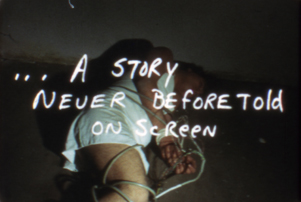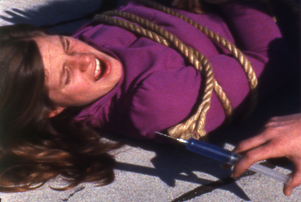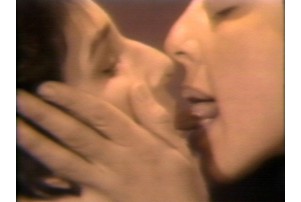Sex Roles: Gender, Liberation, and Sexuality
-
 Hats Off to Hollywood (1972) by Penelope Spheeris
Hats Off to Hollywood (1972) by Penelope Spheeris
-
 Bondage Boy (1973) by Chris Langdon
Bondage Boy (1973) by Chris Langdon
-
 Bondage Boy (1973) by Chris Langdon
Bondage Boy (1973) by Chris Langdon
-
 Bondage Girl (1973) by Chris Langdon
Bondage Girl (1973) by Chris Langdon
-
 Bondage Girl (1973) by Chris Langdon
Bondage Girl (1973) by Chris Langdon
-
 Female Sensibility (1973) by Lynda Benglis
Female Sensibility (1973) by Lynda Benglis
-
 Now Show Yours (1977) by Richard Newton
Now Show Yours (1977) by Richard Newton
-
 Water Ritual #1 (1979) by Barbara McCullough
Water Ritual #1 (1979) by Barbara McCullough
February 12, 2012, 7:30PM
Spielberg Theater at the Egyptian, 6712 Hollywood Blvd., Los Angeles CA 90028
Films and videos exploring the definitions, meanings, representations, and interactions of women and men. Storytelling about past experiences; performances; documentary ahead of its time, social conflicts. Yes, plenty of nudity and adult behavior as well.
There are an enormous number of great works that focus on these themes. These are a few highlights.
In person: Penelope Spheeris (schedule permitting)
Tickets: $10 general, $6 students/seniors; free for Filmforum members
Available on Brown Paper Tickets at http://www.brownpapertickets.com/event/224008
Films to be Screened
-
 Bondage Boy (1973) by Chris Langdon
Bondage Boy (1973) by Chris Langdon
Bondage Boy (1973, 16mm, color, sound, 5min.)
Directed by Chris Langdon“A quiet evening at home with a little twine....” (Chris Langdon)
-
 Bondage Girl (1973) by Chris Langdon
Bondage Girl (1973) by Chris Langdon
Bondage Girl (1973, 16mm, color, sound, 5min.)
Directed by Chris LangdonSometimes a cigar is just a cigar.
“Drugs are bad.” (Chris Langdon)
-
 Hats Off to Hollywood (1972) by Penelope Spheeris
Hats Off to Hollywood (1972) by Penelope Spheeris
Hats Off to Hollywood (1972, 16mm, color, sound, 22min.)
Directed by Penelope Spheeris“Considerably further down the food chain are the demimonde subjects of the eye-opening matched set I Don’t Know [showing at Filmforum 2/24/12] and Hats Off to Hollywood, made by Penelope Spheeris around 1972. Now best known for commercial hits like Wayne’s World, Ms. Spheeris made these two shorts while she was a U.C.L.A. graduate student in film in an overwhelmingly male department. Located at the border of documentary and fiction, the films pivot on the funny and painful misadventures of a beautiful hustler, Jennifer (né Jimmy), whose liminal identity is a source of liberation (for her, for the viewer) and a periodic catalyst for trouble. Exquisitely intimate, the films offer a deeply human alternative to Hollywood’s then dominant vision of the pathological (or dead) homosexual.” (Manohla Dargis, New York Times)
-
Soft Fiction (1979, 16mm, b/w, sound, 54min.)
Directed by Chick Strand“Chick Strand’s Soft Fiction is a personal documentary that brilliantly portrays the survival power of female sensuality. It combines the documentary approach with a sensuous lyrical expressionism. Strand focuses her camera on people talking about their own experience, capturing subtle nuances in facial expressions and gestures that are rarely seen in cinema. The title Soft Fiction works on several levels. It evokes the soft line between truth and fiction that characterizes Strand’s own approach to documentary, and suggests the idea of softcore fiction, which is appropriate to the film’s erotic content and style. It’s rare to find an erotic film with a female perspective dominating both the narrative discourse and the visual and audio rhythms with which the film is structured. Strand continues to celebrate in her brilliant, innovative personal documentaries her theme, the reaffirmation of the tough resilience of the human spirit.” (Marsha Kinder, Film Quarterly)
-
 Female Sensibility, by Lynda Benglis
Female Sensibility, by Lynda Benglis
Female Sensibility (1973, video, color, sound, 14:19)
Directed by Lynda Benglis“Two women, faces framed in tight focus, kiss and caress. Their interaction is silent, muted by Benglis' superimposition of a noisy, distracting soundtrack of appropriated AM radio: bawdy wisecracks of talk-show hosts and male callers, interacting in the gruff terms of normative masculinity; male country-western singers plying women with complaints about bad love and bad coffee; a man preaching on the creation of Adam and Eve. The tape's challenge may, in part, direct itself at the viewer. While one might find it easy to dismiss the gender clichés of the soundtrack, it may be harder to resolve the hermetically-sealed indifference and disconcerting ambiguity (lovers? performers?) of the two women. By turns conscious of the camera and seemingly oblivious to it, their dreamy indifference is a rebuke to the disruptive chatter hovering around them, and perhaps also to the expectations of those who watch.” (EAI)
-
 Now Show Yours, by Richard Newton
Now Show Yours, by Richard Newton
Now Show Yours (1977, digital (orig. super 8), color, sound, 2.5min.)
Directed by Richard NewtonMusic: Kraftwerk, Autobahn. With Linda Frye Burnham, Richard Newton
Boy meets girl…
I’m inspired by the innocence of sexuality.
Now Show Yours is further evidence of the simplicity of female attraction, and
the lengths to which the male species will go, to get noticed…
-
 Water Ritual #1, by Barbara McCullough
Water Ritual #1, by Barbara McCullough
Water Ritual #1: An Urban Rite of Purification (1979, 35mm (orig. 16mm), b/w, sound, 6 min.)
Directed by Barbara McCullough“Made in collaboration with performer Yolanda Vidato, Water Ritual #1 examines Black women’s ongoing struggle for spiritual and psychological space through improvisational, symbolic acts. Shot in 16mm black-and-white, the film was made in an area in Watts that had been cleared to make way for the I-105 freeway, but ultimately abandoned. At first sight, Milanda (Vidato, wearing a simple dress and scarves on her head and waist) and her environs (burnt-out houses overgrown with weeds) might seem to be located in Africa or the Caribbean, or at some time in the past. This layering of locations and temporalities continues to the film’s striking conclusion, in which a now nude Milanda squats and urinates inside an urban ruin. By making ‘water,’ Milanda evokes the numerous female water-based figures in African-Diaspora cosmology as she attempts to expel the putrefaction she has absorbed from her physical environment, while symbolically cleansing the environment itself.
“Structured as a ritual for Barbara McCullough’s ‘participant-viewers,’ Water Ritual #1 honors Black/Third World women’s beauty and self-possession, and has been recognized as a pioneering work in Black feminist and experimental filmmaking....Although the film reflects a chain of abandonments— the city has turned its back on the Black community, residents have vacated their homes, and the deserted homes leave remaining folks like Milanda stranded and desolate—McCullough suggests that sites of urban blight can be activated as consecrated ground.” (Jacqueline Stewart)